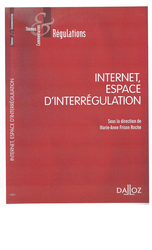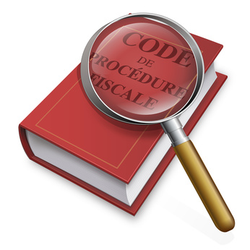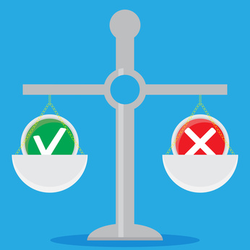Compliance and Regulation Law bilingual Dictionnary

We must give a strict definition of globalization. Globalization isn't simply the intensification of economic exchanges through the lowering of borders and the rapidity of trade, a phenomenon known since antiquity and of which the World Trade Organization (WTO) is today the guardian. Globalization aims at a radically new phenomenon, that of economic exchanges without any constraint of time or place, dealing with goods without corporality since it is information. This is the case for all personal data, all information and all finance (because financial instruments can be analyzed as information), which through technology flows out of space and in an instant. In what can be called "real virtuality", states and law do not know how to grasp normatively this new reality, because until now they had only apprehended palpable objects in spaces enclosed by their borders . Globalization, therefore, is a radical change the world, that has radically changed the game.
Compliance and Regulation Law bilingual Dictionnary
L’Autorité de Régulation des Communication Electroniques et de la Poste (ARCEP) est une Autorité Administrative Indépendante (AAI). Elle a succédé en 2005 à l’Autorité de Régulation des Télécommunications (ART), laquelle fut créée en 1996. L’ART fût la première autorité de régulation du genre, inaugurée sous l’impulsion du la vague de libéralisation des secteurs naguère en monopole .
L’ARCEP a une compétence plus vaste de celle de l’ART, régulant également les activités postales et a pour office de favoriser l’exercice d’une « concurrence effective et loyale au bénéfice des utilisateurs », ce qui la rapproche singulièrement de l’office général de l’Autorité de Concurrence. Ce régulateur doit encore tenir compte de l’ « intérêt des territoires » et de l’accès des utilisateurs aux services et aux équipements. L’ARCEP a compétence pour réguler ce qui transporte les informations (contenant) tandis que le a compétence pour réguler les informations transportées (contenu). Cette distinction contenant/contenu fonde donc la dualité des régulateurs. Mais en premier lieu elle est fragile et peu utilisée à l’étranger, d’autres pays préférant avoir un seul régulateur pour le contenant et pour le contenu, dans la mesure où les informations peuvent passer par divers contenants (par ex. télévision ou le téléphone). En second lieu Internet rend difficile le maniement de cette distinction. C’est pourquoi on évoque parfois l’hypothèse de fusion des deux autorités de régulation.
L’ARCEP surveille les marchés de gros, dans lesquels les opérateurs doivent se comporter d’une façon transparente, non discriminatoire et publier une offre de référence. Il les prix et oblige à une orientation du tarif vers le coût, favorisant en aval c'est-à-dire (marché du détail) le dynamisme concurrentiel. Sur celui-ci, le régulateur veille à de transport et au réseau de distribution jusqu’au final (problématique de la . L’ARCEP a le pouvoir d’attribuer les fréquences aux opérateurs, lesquelles sont des et dont l’attribution peut être retirée à l’opérateur en cas de . Mais au-delà de ces dimensions très techniques, le régulateur exerce une fonction parce qu’il projette dans le une certaine conception qu’il a du secteur. Ainsi il peut estimer ou non que la fibre optique doit être ou non favorisée et contraindre les opérateurs en ce sens. De la même façon, il peut adhérer à la théorie de la « » au nom de laquelle il va imposer aux propriétaires d’un réseau de l’ouvrir à des utilisateurs, même au prix d’investissements pour les accueillir, le régulateur fixant alors l’indemnisation d’un tel . L’adhésion à cette théorie, très discutée, n’est pas de nature technique mais politique.
L’ARCEP dispose du pouvoir précité de retirer des fréquences aux opérateurs ne remplissant pas leurs obligations et peut prendre des mesures conservatoires. Celles-ci peuvent être attaquées devant la Cour d’appel de Paris. L’autorité exerce un pouvoir deet d’un pouvoir de . L’ARCEP publie un rapport annuel, façon pour l’Autorité de , ce mode de étant mis en balance avec son .
Comme en 1996 pour les télécommunications, à partir de 2005 le régulateur a ouvert à la les activités , tout en veillant à la poursuite du postal. La Loi du 9 février 2010, tout en transformant la Poste en société anonyme a veillé à maintenir ses obligations de service public et les a même étendues en lui confiant des obligations d’aménagement du , montrant avec la régulation . Par ce contrôle, le régulateur exerce un pouvoir plus que technique.
Compliance and Regulation Law bilingual Dictionnary

A monopoly refers to the power of a person to remove from a good its utility by excluding others. The monopoly refers to a situation on the market, the monopolist being the sole operator in the market. Lawyers are accustomed to the monopoly conferred by Law, for example the one that was the monopoly for the national public enterprise for electricity. In this case, what is done may be defeated, and the legislature may withdraw that privilege especially if the author of this norm is better placed in the hierarchy of norms than the previous author. For example, the European Union legislature withdrew the legal monopolies by means of directives from most of the operators holding them in the regulated sectors in order to liberalize them.
But the monopoly can have an economic source. Indeed, it may happen that a first operator constructs a structure, for example a wired telecommunications transport network. Because he is alone, agents on the market must resort to him to carry their communications, his business will be profitable. But from there, if a second operator built such an infrastructure, it would inevitably be in deficit for insufficient applicants. This is why no rational economic agent will build a second network. Thus, this network will remain unique. It is then an economically acquired monopoly that the legislative will can not change its nature. That is why it is called "natural".
Since what is can not be changed, Community law has taken note of the monopolistic nature of the majority of networks and the correlated power of their owner or manager, but has correlatively provided for their supervision by a regulator who not only Ex post to resolve possible differences between the infrastructure manager, the natural essential facility, and the one who wants to access it, but also, through an Ex ante power, to negotiate with that manager the return on his capital, his commitments investment in the network, etc., or even more directly by imposing on it the way in which it fixes access tariffs and so on.
These economically natural monopolies are therefore more powerful than legal monopolies, which States and lawyers have taken a long time to understand, but this also explains the reverse tendency of economists to write laws, The texts must handle this type of notions, its writers caring little about the political order and legal notions. The fact that the laws and regulations on regulated situations and supervised operators have long been elaborated solely from the point of view of lawyers, particularly of the public service, which was regrettable, does not justify this passage from one extreme to the other.
Compliance and Regulation Law bilingual Dictionnary

"Network industry": this is an expression easily used to designate economic activities which involve a "transport network", which includes telecommunications (which carries voice, images, "data"), railways ( which carries cars, people, goods), electricity (which carries electrons), post office (which carries letters, packages), highways (on which cars and trucks run), etc.
It is also customary for them to oppose banking, finance and insurance activities, which develop in businesses (banks, insurance companies) or in places (financial markets).
This presentation, however usual it may be, is not very happy in that it opposes the two types of activity. This "opposition" undoubtedly corresponds more to the fact that the first economic activities are traditionally governed by public Law because they were the fruit of public enterprises under the supervision of the State and the control of the Conseil d'Etat, while the second activities economic, because the issuers of securities or insurance contracts are private companies, are subject to private Law and control by the judicial jurisdiction.
Indeed and in reality, financial centers, like networks, constitute essential facilities and banking regulation resembles energy regulation in many ways, both centered on risk. Having thus given way to the autonomous concept of network industries at this point is in practice harmful, in particular by the fragmentation of knowledge and jurisdictional skills.
Even more, the development of digital technology, which today constitutes a global space perhaps synonymous with "globalization", sweeps away this distinction because digital technology only develops with the support of a network (the web) and in this space all activities take place. deploying, in particular banking and finance, while the question of data becomes a primary issue there, data no longer being the prerogative of "network industries".
Compliance and Regulation Law bilingual Dictionnary

Almost all energies are products whose economic circuit is regulated, in a more or less homogeneous way. Thus, gas and electricity are often regulated by the same authorities, as in France, regulation entrusted to an authority which in 2000 was first the Commission de Régulation de l’Électricité - CRE (French Commission of regulation of the electricity) to become the Commission de Régulation de l'Energie -CRE (French Commission of regulation of the energy), extending its competence to gas. Renewable energies, such as photovoltaic (solar panels), or wind energy (wind) or energy through water (dams) are more subject to State plans in the hands of the traditional administration. As for oil, it is currently regulated only through an agreement between producing countries, OPEC (Organization of Petroleum Exporting Countries), which smooths the market movements with the perverse effects that are known.
Energy is a regulated sector because at the same time it is made up of scarce resources (except the renewable energy hypothesis, which is currently privileged and elevated to the rank of European policy) even though energy is the support of all ordinary markets for goods and services since there can be no economic activity without an efficient and reliable energy system over the long term.
As regards transport, which is based on the control of an essential infrastructure, Community aw still tolerates that the companies which manage it remain the property of the incumbent operators of which they are the subsidiaries, There is an accounting separation between its producers and its managers, consolidated by a distinction of legal personalities. The network operator is a "crucial operator", since all energy is a network industry. It therefore has multiple public service obligations, in particular to assure th buyers' and sellers"e right of access of energy. It is common for disputes to arise between the latter and the network operator, which are then brought before the regulator, in France the CRE giving a solution ;; its decision may be challenged before the Court. The distribution activity is closely linked to the transport activity in terms of energy, and the same difficulties with respect to access to the meter are not found in access to the meter to the local telecommunication loop.
Moreover, acts of sales and purchases in the energy sector are not part of a competitive logic. Often, it is still the Government that sets the selling price of electricity and gas, while oil Is left to the price resulting from an agreement between dominant producers of the market. France has experienced the saga of the possibility for consumers to leave the regulated price system to adopt the free price, the French Parliament by the law of 10 July 2008 having chosen to leave the free prices to return to the regulated prices if they are more favorable to the consumer.
We therefore see that the aim of energy regulatory system is to open up to competition but also to optimally manage these scarce resources, which are rare even when they are indispensable. That is why the nuclear issue is central to the countries that have made the choice and are continuing to do so. The issue of energy transition is now a major major issue. In France, it is now based on the Law of 17 August 2015 on the Energy Transition for Green Growth. Here we see how long-term regulation, industrial policy and innovation are linked.
Finally, energy generates activity both at very long term and at very high risk. This is why it does not support the simple mechanism of the competitive market. We must think of this sector as the banking sector because it is characterized by systemic risks, the system not being able to authorize itself for example a nuclear explosion. The Californian energy crisis is equivalent to a financial crisis. Energy requires decennial planning and considerable investment. States are required.
Compliance and Regulation Law bilingual Dictionnary

Formally, the legal system had constructed the regulatory authorities in the form of Independent Administrative Authorities (AAI).
The stake being to build their independence in an institutional and consubstantial way, the Legislator conferred a new status: that of Independent Public Authority (API). Thus, the Autorité des Marchés Financiers (AMF), the Commission Nationale Informatique et Libertés (CNIL), the Haute Autorité de Santé (HAS) or HADOPI are classified among APIs and not only among IAAs.
We must therefore see two distinct legal categories, AAI on the one hand and APIs on the other.
Thus the two laws of January 20, 2017 relate, to better supervise them, both on AAIs and on APIs, but reading the preparatory work shows that the two categories show that they are treated in a fairly common way. Even more if one consults the sites of certain regulatory authorities themselves, such as HADOPI, for example, it presents itself as an "Independent Public Authority" but defines this legal category as being that which targets the Authorities. Independent Administrative .....
It thus appears that the category of Independent Public Authorities is above all marked by the symbol of a greater dignity than that of the category of "simply" Administrative Independent Authorities. From a technical point of view, the two categories are essentially distinguished from a budgetary point of view, financial autonomy being the nerve of independence. This is how the AMF's budget is based on the size of market operations, through tax mechanisms that are not included in the LOLF. Independence does not extend to autonomy, the API does not negotiate its budget with Parliament, since an Independent Public Authority is not a Constitutional Authority.
Compliance and Regulation Law bilingual Dictionnary

For the benefit of the consumer and the efficiency of systems, networks should cover as large a territory as possible, for example Europe. For this, there must be a mesh between the different networks so that, for example, travelers or electric or electronic waves can pass from one to the other. This capability is referred to as interconnection.
This interconnection is particularly delicate at the borders between countries and that is why regulators often have specific and greater powers with regard to the interoperability of cross-border networks. Thus, to take the example of the European telecommunications agency, set up in 2010, this simple agency has no real regulatory power, more like a simple observatory gathering and disseminating data, except in this regard. which concerns cross-border interconnections.
If there is no interconnection, there cannot be a common system. This can be set up by the standards. A classic example is that taken from the gauge of railway tracks, different between France and Germany, which prohibited the interconnection of the railways of the two countries, to which the standardization of materials and constructions has put a term.
Compliance and Regulation Law bilingual Dictionnary

Regulation has arisen from the need to take account of the specific nature of the sectors, often accompanied by their liberalization.
But, first of all, goods from different sectors can be substitutable. Thus, both gas and electricity can be heated, as intermodal competition makes the segmentation of regulation of the electricity sector and regulation of the gas sector less relevant to the idea of a single sector of "energy", which nevertheless allows the regulation of water and oil out of its grip. Similarly, a life insurance contract is both an instrument of protection for the future, a product that is therefore covered by insurance Regulation, but also a financial product placed with consumers by banking-insurance companies, objet to the banking regulatory control. This intimacy of regulation with respect to the internal technicality of the object on which it bears can not be erased.
The interregulation that will take place is initially institutional. That is why an alternative opens: either the regulatory authorities are merged, and thus the UK's Financial Services Authority (FSA) has merged financial and banking regulation in 2000, what has not done the French system. Thus, the first branch of the alternative is the institutional fusion, at the risk of constituting kinds of titans, or even reconstituting the State. Either procedures for consultation and joint work are established to create contact points, or even a common doctrine among regulators, as it is between ESMA, EBA and EIOPA in the UE regulatory mechanisms.
The other branch of the alternative is to respect this initial relationship between regulation and the sector and to take note of the links between sectors through the proposed concept of "interregulation". This involves setting up networks between autonomous authorities, but exchanging information, meeting, collaborating on common issues, and so on. This interregulation may initially be horizontal when authorities from several sectors collaborate, for example, ESMA, EBA and EIOPA. It may also be vertical when the authorities of national sectors collaborate with foreign authorities or European or international authorities, as envisaged by the Lamfalussy process in financial matters (extended to the banking and insurance sectors) or the Florence Process in the field of telecommunications or the Madrid Energy Process, where European national regulators meet and work together. This can take more formal institutional forms, such as in telecommunications, with BEREC, or in energy matters with ACER, with and around the European Commission. The comitology technique has generalized this institutional formula.
Interregulation is then notional, a "common law" of regulation developing, common between all sectors. This "common law" (horizontal law) came after the maturity of sectoral regulation laws (vertical laws). It develops in fact because regulated objects are located on the border of several sectors, or even ignore these borders : for example financial derivatives on underlying agricultural or energy. Moreover, "connected objects" generate interregulation in digital space. Thus, even though it is possible that the Internet may give rise to an "interregulation" before giving rise to a specific regulation, the latter can then justify that the first one is dispensed with. That has not happened yet. This regulation of the digital world should be global. It is therefore possible that there remains a mechanism of interregulation.
Compliance and Regulation Law bilingual Dictionnary

In a self-regulated system (such as a market governed by free competition), the equilibrium operates spontaneously by the meeting of the whole of the supply with the whole of the demand, as soon as the information is given on prices. The snag that constitutes an anti-competitive practice, cartel or abuse of a dominant position, which prevents the emergence of the break-even price, is repaired on an ad hoc basis and ex post by the Competition Authority.
But Regulation intervenes in the event of a market failure: Regulation then has the primary function of building balances which are not established and do not maintain spontaneously. For example, this will involve a balance between competition between banks on the one hand and the prevention and management of systemic risk on the one hand, which implies a certain coordination between banks, coordination close to the agreement.
In the same way, the Regulator will have to build a balance between the principle of competition, with exact prices which can therefore be high, and social tariffs for populations in difficulty having nevertheless to gain access that the Politics will have posed as being a "common good. ", like certain drugs, even electricity.
These unstable balances must be maintained in the long term. This is why the Regulator, unlike the Competition Authority, does not intervene on an ad hoc basis but is permanently present, in a way internalized in the sector that it continuously monitors and controls. These long-term balances justify recourse to multi-year plans, in particular through contracts for example in postal matters or concerning airports (regulation contract), the contract making it possible to stabilize apprehension of the future.
Compliance and Regulation Law bilingual Dictionnary

The Autorité de Régulation des Communications Electroniques et de la Poste (ARCEP) is an independent administrative authority (AAI). In 2005, it took over from the Autorité de Regulation des Télécommunications (ART), which was created in 1996. ART was the first regulatory authority of its kind, inaugurating under the impetus of European Union Law the wave of liberalization of previously monopolistic sectors. ARCEP has a broader competence than that of ART, also regulating postal activities and its role is to promote the exercise of "effective and fair competition for the benefit of users", which brings it particularly close to the general office of the Autorité de la concurrence. This regulator must still take into account the "interest of the territories" and user access to services and equipment.
ARCEP has jurisdiction to regulate what carries information (container) while the Conseil Supérieur de l'Audiovisuel (CSA) has jurisdiction to regulate the information transported (content). This distinction between container and content therefore forms the basis of the duality of regulators. But in the first place it is fragile and little used abroad, other countries preferring to have a single regulator for the container and for the content, insofar as the information can pass through various containers (e.g. television or the telephone) as in the United States (Federal Communication Commission - FCC). Second, the Internet makes it difficult to handle this distinction. This is why the hypothesis of a merger of the two French regulatory authorities is sometimes mentioned.
ARCEP monitors wholesale markets, in which operators must behave in a non-discriminatory manner and publish a reference offer. It controls prices and forces a price orientation towards cost, favoring downstream, that is to say (retail market), competitive dynamism. On this, the regulator ensures access to the transmission network and the distribution network to the end consumer (local loop issue). ARCEP has the power to allocate frequencies to operators, which are scarce resources, the allocation of which can be withdrawn from the operator in the event of a breach. But beyond these very technical dimensions, the regulator exercises a political function because it projects into the future a certain conception it has of the sector. Thus it can estimate or not that the optical fiber should or not be favored and force the operators in this direction. Likewise, it can adhere to the theory of “net neutrality” in the name of which it will force the owners of a network to open it up to users, even at the cost of investments to accommodate them, the regulator then fixing the compensation for such a right of access. Adherence to this much debated theory is not technical but political in nature.
ARCEP has the aforementioned power to withdraw frequencies from operators not fulfilling their obligations and can take protective measures. These can be challenged before the Paris Court of Appeal. The authority exercises the power of dispute resolution and the power of sanction. ARCEP publishes an annual report, a way for the Authority to report, this mode of responsibility being balanced against its independence.
As in 1996 for telecommunications, from 2005 the regulator opened up postal activities to competition, while ensuring the continuation of the public postal service. The Law of February 9, 2010, while transforming La Poste into a public limited company, ensured that its public service obligations were maintained and even extended them by entrusting it with spatial planning obligations, showing interregulation with environmental regulation. Through this control, the regulator exercises more political than technical power.
Compliance and Regulation Law bilingual Dictionnary

Regulation Law presupposes moving from a political conception of acts (that is to say, a collective decision expressed by the State) or a civilist one (that is, a will expressed by one or several individuals in one Contract) to an economic vision of organizations whose action is the expression of the market. If one relies on the adjustment of supply and demand, that is to say, the meeting of desires and interests, there will be "self-regulation", which is the "law of the Market ", referring to Competition Law. The act of the operators is only a reflection of this sort of natural law, in action.
Regulation is then more complex because it integrates this economic rationality of the actors and systems in which the first onese are agents (homo economicus), but Regulation aims at something other than this mechanical rationality, either because of a market failure (for example in case of natural monopoly) or because the author of the standard, eg the State or the Regulator wants to obtain more than the market can give (eg access to common goods such as health) , even for insolvent claimants).
In this case, special written norms are drawn up, ex ante interventions designated in English by the term of "regulations" (and in French by the term of "réglementation"). The Regulation Law, the regulatory system, is adequate if it constitutes an incitation for economic agents to adopt behaviors that concretize the aim sought by the author of the regulatory mechanisms.
The Regulation Law will then rely on economic science to produce the right "incentives", leaving agents - producers, supplyers, claimants, consumers, taxpayers, the most diverse stakeholders - free to make choices, but inciting them to make choices that will produce in isolation or in a comprehensive or cross-breeding way, immediately or in the long term, a result corresponding to that which was intended from the outset by the person who designed the standard. In this respect, the Law of Regulation is highly strategic, whether of a technical nature, aimed at mitigating a market failure or more political. In this, it is also of a liberal nature, since it is not orders formulated to obedient people, but spaces of freedoms constructed for the benefit of persons.
This strategic use of Law then requires the necessary detour through the economic analysis of Law, that is to say the analysis of Law in its economic effects. It presupposes, among those who use the norm, not only the Legislator but also the Judge, a knowledge of the economic mechanisms, for example the theory of incentives, incomplete contracts or behavioral economics, three liberal theories on which are based the interventions Ex Ante of the public authorities and which the judgments of the Courts extend.
That is why the Economic Analysis of Law is a fully discipline. It was created in the United States by Ronald Coase (Nobel Prize for Economics in 1991). It may be merely descriptive and reveal what economic effects the Law has produced. This conception, in particular that of Richard Posner, makes the economic analysis of the law an instrument of expertise for the political decision-maker who can take it into account in order to modify the norms, and for the judge, who can take it into account for Interpreting them. A more radical conception of the so-called normative economic analysis of law is to argue that the conclusions of the analysis would oblige the decision-maker and the judge to adopt the "efficient" interpretation designated by the economic analysis without being legitimate for adopting others.
Philosophical in nature, this issue is decisive because in the first case the law and the jurists - in particular the Legislator and the Judge - still have an autonomous existence, in the second case they no longer exist really, are only the formal and explicit binding of the "law of the market" whose nature is non-legal. Law then is a way of execution, a pure and simple effectiveness of a another essential Law that is external to it, that of the "Law of Market, which is the adjustment of the offer and the demand.
Common law systems tend to fall into the normative excess of confusing what is merely a description of choice and to adopt what would be a "decision" taken by the economists themselves: Law then, as a normative system, is only what gives the enforceability and legal certainty of what becomes truly normative, e.g. the economic value of the adjustment of supply and demand. Civil Law systems integrate the Economic Analysis of Law in a manner more in keeping with the thinking of founders or current theorists such as Cass. Sunstein, allowing Legislators and Courts to integrate the economic dimension of situations without their economic reasoning implying the solution to be retained, as choices remain in Law, expressing values, and in legal systems being governed by their own legal notions and rules, at a distance from the Economy.
Even in its descriptive form, the economic analysis of the law is generally rejected in France as it disregards the role of the law in that it carries moral values. It is in reality to ignore its merely descriptive, instructive and useful function, and the fact that it opens instead the amplitude of the rational choice offered to political decision-makers and courts. Moreover, regulation is not only a technical discipline, it is also a political and philosophical issue. Descriptive economic analysis is more appropriate than the normative economic analysis of the law, which claims to vassalize and even destroy the other disciplines, which are substantially ignored.
Compliance and Regulation Law bilingual Dictionnary

A public enterprise has long been characterized by the fact that a public person, for example the State or a local public authority, holds the majority of its capital, which is before a formal legal criterion. The European Union Law, in a more concrete perspective, has apprehended it more directly purely and simply as an enterprise, that is to say, an organization having an economic activity on a market, irrespective of the private or public nature of the capital of the company, a legal instrument by which the undertaking enters into the legal under the "decisive influence" of a public person, not only actively (alliance in bodies or by contracts) but also passive (guarantees, etc.).
Competition law, analyzing people by their activities, could be said to have "killed" the public enterprises by ignoring the particular nature of this public shareholder (the figure of the "shareholder state") since legal reasoning wants to see State only as an ordinary shareholder, where the subject of public law identifies itself as defending the general interest. This banalisation is not definitive: by the nationalization of banks as a remedy to the financial crisis in Great Britain or in the United States, the State again claims that a public company does not have the same purpose as a private company, because the former, like its shareholder, pursues the general interest through its intrinsic mission, while the private company, through its ordinary shareholder, pursues the maximization of profits, mirroring that pursued by the expectation of dividends by the ordinary shareholder.
There is a fundamental ideological rupture between the Regulation exercised by the undertakings themselves, insofar as they are public (and supervised by the supervision of the State), and the Regulation exercised by a Regulator over all companies in the imposed indifference of their shareholders.
This difference continues to be like a wound between the different models of Regulation and more generally between the conceptions of relations and modalities of relations between the State and the market economy.
Compliance and Regulation Law bilingual Dictionnary

In the continental tradition, particularly in France and Germany, the general interest is served by the State. In the more liberal British and American tradition, the general interest is merely the addition of individual interests, the market being thus able to serve the latter. This assertion, which is essential for the way competition law and the public service are articulated, is questioned in continental culture, particularly in France.
In this historical, philosophical and cultural context, Regulation can have the function of balancing the principle of competition which would be limited to the particular interests of those who have the ability to be market players on account of their solvency and knowledge , and the general interest that cares and the interest of the weak (in money, knowledge, technical skills) and the interest of the social group in the long term.
This general interest has long been expressed through the French notion of public service. It was still reflected in the theory of Regulation when it is the policy that imposes that competition should give way to a consideration that is contrary to it, for example access to a common good such as health or education.
Today, by the concepts of Compliance and, adjacent to it, Corporate Social Responsibility, it is possible that the general interest is the notion on which "public interest entities" can find themselves, in order to serve a Interest that goes beyond the people who compose, direct and serve these entities, whether public (state) or private (large international groups, crucial operators).
Compliance and Regulation Law bilingual Dictionnary

Rating agencies are private companies that assess the risk of defaulting payment by debtors. As such, the rating of a borrower affects the value of the debt security it issued and that is to circulate in the markets. That is why the activity of credit rating agencies is critical to the security of financial instruments and the functioning of financial markets, but also to the whole global credit system. For instance, an AAA rating guarantees security to investors. Rating agencies helps building trust in financial markets and in the banking system. Henceforth, since everyone relies on them as they save people's time from seeking on their own information on securities or on those who issue them on the marks, international rating agencies have become crucial operators.
'Rating' has also become a business, which is now concentrated within the hands of three undertakings (two American and one French). It has often been said that these three are conflicted. Some have indeed brought up the fact as they have provided the markets with unreliable information (especially about subprime and securitization) prevented them to self-discipline, which eventually participated in the global spread of risks and defaults.
The difficult history between the rating agencies, whether they are considered as mere businesses, crucial operators or as companies undertaking a public service, which eventually led to implement a specific Regulation in the immediate aftermath of the financial crisis, shows how the information is a public common. This justifies the intervention of the Financial Regulator, namely to better protect the consumer. Should we go further on? Some have mentioned the idea of nationalizing the business and hand it over to Government institutions (or at least public ones). This is, however, no longer on the agenda, as many conflicts of interests may arise since rating agencies keep on rating the paradoxical debtors that States are.
Compliance and Regulation Law bilingual Dictionnary

The theory of essential facilities was invented in the United States (essential facilities) by the Supreme Court in a judgment of 1911, based on competition Law alone.
The Court ruled that the operator of a transport network has a natural monopoly since no other economic agent will duplicate it. Therefore, by this fact alone, it is in a dominant position and has the power to impose its prices on companies that have no other solution than to request from it access to means of transport. The Court considered that there was abuse of a dominant position, either because there was refusal of access, or because there was too high a price for this access, the sanction then not being damages but compensation in kind consisting in forcing the network operator to open up access to it at a fair price to its competitors.
Thus the theory of essential facilities, taken up in Community Law in 1978 and then in French Law, made it possible on the sole basis of competition Law and by judicial ingenuity to achieve the same ex post result as an ex ante regulation system. network industries.
Compliance and Regulation Law bilingual Dictionnary

The notion of "Common Goods" refers to a political conception insofar as it concerns objectively commercial goods such as cultural goods or medical services, but which the community is going to demand that everyone should have access to it even though the individual does not have the ability to pay the exact price. It is then the taxpayer - present or future - or the social partners who bear the cost, or even some companies, through the corporal social social responsibility mechanism.
This protection of Common Goods can be done by the State in the name of the interest of the social group for which it is responsible and whose it expresses the will, particularly through the notion of the general interest. In this now restricted framework which is the State, this reference runs counter to the principle of competition. This is particularly clear in Europe, which is based on a Union built on an autonomous and integrated legal order in the Member States in which competition continues to have a principled value and benefits from the hierarchy of norms. The evolution of European Law has balanced the principle of competition with other principles, such as the management of systemic risks, for example health, financial or environmental risks and the creation of the banking union shows that the principle of competition is no longer an apex in the European system.
But it still remains to an economic and financial conception of Europe, definition that the definition of the Regulatory Law when it is restricted to the management of the market failures feeds. It is conceivable that Europe will one day evolve towards a more humanistic conception of Regulatory Law, the same one that the European States practice and defend, notably through the notion of public service. Indeed and traditionally, public services give people access to common goods, such as education, health or culture.
Paradoxically, even though Law is not set up on a global scale, it is at this level that the legal notion of "common goods" has developed.
When one refers to goods that are called "global goods", one then seeks goods that are common to humanity, such as oceans or civilizations. It is at once the heart of Nature and the heart of Human Being, which plunges into the past and the future. Paradoxically, the concept of "global goods" is still more political in substance, but because of a lack of global political governance, effective protection is difficult, as their political consecration can only be effective nationally or simply declaratory internationally. That is why this balance is at present only at national level, which refers to the difficulty of regulating globalization.
Thus, the "common goods" legally exist more under their black face: the "global evils" or "global ills" or "global failures", against which a "Global Law" actually takes place. The notion of "global evils" constitutes a sort of mirror of Common Goods. It is then observed that countries that develop legal discourse to regulate global evils and global goods thus deploy global unilateral national Law. This is the case in the United States, notably in financial regulatory Law or more broadly through the new Compliance Law, which is being born. Companies have a role to play, particularly through Codes of Conduct and Corporate Social Responsibility.
Compliance and Regulation Law bilingual Dictionnary

The expression is always left in the English language even when it is used in other languages because it is not translatable. It refers to the basic institutional and political mechanism of the American system. Regulatory theorists and practitioners often refer to it as the right political and institutional framework on which to base an economic organization of Regulation. This would mean a need to reform the political systems built on another mode of separation of powers.
This strong basis conforts the fact that the system of Regulation is not neutral, it is the reflection of a political organization.
The shock between these different philosophical and political conceptions explains why economic regulation has been difficult to accept in Europe, and especially in France for a long time. Indeed, according to the French political scheme resulting from the Revolution, there are two powers: the executive and the legislative, the judiciary being only an authority. The executive is built on the hierarchical principle of which the head is constituted by the government, any administration ultimately coming from a minister. It is therefore a vertical system, which has the merit of simplicity. Regulatory authorities have been imposed by European directives since the 1990s, in the form of bodies which may be administrative and Under this title of the State but must be necessarily independent of the government from the moment that operated on the market of the public enterprises which also obeyed the government through the theory of the state shareholder.
Le choc entre les deux conceptions philosophiques et politiques explique que la régulation économique ait eu du mal à être acceptée en France pendant une longue période. En effet, selon le schéma politique français issu de la Révolution, il existe deux pouvoirs : l’exécutif et le législatif, le judiciaire n’étant qu’une autorité. L’exécutif est construit sur le principe hiérarchique dont la tête est constituée par le gouvernement, toute administration relevant finalement d’un ministre. Il s’agit donc d’un système vertical, qui a pour lui le mérite de la simplicité.Les autorités de régulation ont été imposées par des directives européennes à partir des années 90, sous la forme d’organes pouvant être de nature administrative et relevant à ce titre de l’État mais devant être nécessairement indépendants du gouvernement dès l’instant qu’opéraient sur le marché des entreprises publiques qui elles aussi obéissaient au gouvernement à travers la théorie de l’État-actionnaire.
This is the fundamental European rule of the impossibility of cumulation of the regulatory / operator state, a situation constituting a conflict of interests. The French State, which intends to remain owner of public operators, in particular EDF, has preferred to relax control of regulation by creating independent administrative authorities (AAI).
Consequently, the vertical model of the hierarchy of the executive has been disrupted since these authorities no longer report (as free electrons) of it. For them to be held accountable, judicial review of the authorities through appeals has been increased. In the same way, through public reports to Parliament, the IAAs began reporting directly to the IAA. The political model becomes horizontal.
This then refers to a completely different tradition: that of the United States. Indeed, in the United States, the executive (the White House) has both the Parliament (the Congress) and a very powerful judiciary (the Supreme Court); No one has taken over the others, each however being able to hold the others accountable. This is called Check and Balance. Not least because the Regulation has been institutionalized by economists who, through the current Law and Economics, have perceived what they consider to be the most appropriate right as American law, which must impose itself almost "by nature".
Thus, through this small corner in the door that is the institutional reform introduced by regulation, the French political system evolves towards this American system of check and balance, being observed that the United States were the first historically to put in Regulators. This rapprochement of the systems can be carried out all the more so as in Europe the organs in charge of the control of the constitutionality control do not stop increasing in power. Thus, in France, since the constitutional reform of 23 July 2008, the Constitutional Council can assess the constitutionality of laws not only before their promulgation but even when they have entered the legal order, It is becoming a "Supreme Court" on the American model.
The political models remain very different, in particular because the French Parliament does not have the same blocking power as the US Congress, and the Constitutional Council does not have the same doctrinal power as the US Supreme Court. Leaves France in the place of a presidential system virtually without balance, face to face Regulators and the system of the European Union, Europe more and more a Europe of Regulation.
Compliance and Regulation Law bilingual Dictionnary

The goal for which a mechanism, a solution an institution or a rule is adopted, instituted or elaborated, is in principle external to them. Knowledge of this goal is a tool to better understand them and is only that.
On the contrary, in Regulation Law, the goal is the heart itself. By definition, Regulation Law is a set of instruments that articulate to take their meaning in relation to a goal. Moreover, these instruments are legitimate to represent a constraint only because they realize a goal which is itself legitimate. The interpretation of Regulation Law is based on the aims pursued: the reasoning is teleological.
This teleological nature explains that efficiency is no longer merely a concern - as for ordinary legal mechanisms, but rather a principle of Regulation Law. It explains the welcome, especially through the European Union Law of the theory of the useful effect. This link between rules, which are only means, and aims, refers to the principle of proportionality, which requires that constraints and exceptions be applied only when they are necessary, proportionality being the form off the classic principle of necessity.
Because the aim is the center, it must be expressed by the author of the Regulation standards, and this is all the more so if they are of a political nature, being not limited to mitigating technical failures of markets. This goal can be varied: the management of systemic risks, but also the consideration of the fundamental rights of people, the preservation of the environment, public health, civilization, education, etc. The silence of the legislature, which limits itself to the making of rules whereas these are merely instruments, without explicating the goal whereas the latter is a political decision, is a fault in the legislative art.
Moreover, in order that the person who applies the Regulation norm, in particular the Regulator and the Judge, has no excessive margin for interpretation and does not substitute for political power, the author of the Regulation norm needs to aim specifically for one goal : in this way, the one who applies the norm will be constrained. Or, if the author targets several purposes, then he must articulate them in relation to each other, by hierarchizing them for example. If he fails to do so, the institution which applies the regulatory standards will itself have to choose the purpose and exercise a power which he does not possess.
This express designation of purpose has been made for the European Banking Union, this Regulation and Supervision construction, whose primary aim is to prevent systemic risks and resolve crises. Similarly, the purpose of the Regulation of essentiel infrastructures is to provide third parties access to the network. Similarly, in the case of a transitional regulation introduced following liberalization, the aim is to establish competition, the principle of which has been declared by the liberalization law. When this is not clearly stated, there is a lapse in the legislative art.
Compliance and Regulation Law bilingual Dictionnary

Compliance is a concept born mainly in the United States and it is difficult to translate it, for instance into French, as the term "conformité" is not entirely adequate. Compliance is not only the obligation of certain professionals, such as investment service providers (ISPs) to comply with their professional obligations, nor does it extend to the general obligation to comply to all laws and regulations, this obligation to submit to the Law targeting all persons and characterizing the very power of Law.
Compliance is rather the internalization in some companies of specific obligations, resulting from regulatory systems. Thus compliance consists in internalizing the regulatory systems themselves in operators. In order to ensure the effectiveness of this internalization, the companies in question become transparent, the Regulator, or even the criminal judge, who can permanently and in Ex Ante check the proper functioning of the company for the implementation of the rules. The supervision of the company thus allows the effectiveness of the internalization of regulation in the company.
The company is then forced, including by criminal law, to use its power to achieve goals that are a priori external to it, such as the fight against money laundering, the fight against international terrorism and even the protection of human rights. The State thus enacts the aims and the enterprise implements them, the State having the legitimacy to do so but being too weak, in particular because it is enclosed within its borders, the enterprise having the power to do so.
This implies that compliance refers only to a very specific and legally new category of companies: companies with an international activity and having the power to structure themselves to achieve their goals. Law constructs a companie duty to structure itself in this sense: compliance is inseparable from governance.
But these companies thus newly constrained by the consideration by the Law of the globalization do not remain passive. They are actively involved in the normative creation of compliance and, in particular, through ethical charters and codes of conduct, demand the issuance of standards of behavior for all persons who depend on them, both internally and externally, A new culture of compliance, in which respect for meaning is essential and goes beyond the technical differences between legal systems. The emergence of a Global Law can take this path.
Compliance and Regulation Law bilingual Dictionnary

The intensification of the exchanges around the planet is distinguished from globalization in that the first phenomenon refers to the acceleration of economic exchanges without being confused with the disappearance of the space and time of the combined mechanisms of finance and digital, which is expressed by the term "Globalization".
In its strict and classical sense of intensification of exchanges around the globe, globalization ("mondialisation" in French) is not a new phenomenon; it has simply taken on a new dimension: globalization is an intensification of trade in goods and people. It is not a disappearance of circulations, encounters and exchanges, which on the contrary constitutes "globalization,, in the new sense of the term.
Free world trade presupposes that borders can not be opposed to the movement of goods and the World Trade Organization (WTO) has been set up for this purpose, the Marrakesh Accords of 1994 conferring on this organization a very great power , Since two conflicting states have their own disputes settled by a dispute settlement body whose report is endorsed by the WTO itself. The State whose enterprises have been the victim of an illegitimate tariff or non-tariff barrier, can itself inflict retaliatory measures on the guilty state by a kind of private justice. The WTO mechanism is concerned with goods and not with financial mechanisms, which do not even need to remove borders and other barriers, since their immateriality has already destroyed the limits and is thus a matter of "globalization", in the second and new sense of this term.
Globalization, in its strict sense of intensification of exchanges, is thus establishing market law on a global scale, even though this system has not yet become legalized to the point of establishing a global Competition Law as such, since the absence of a barrier to entry is just the first principle of this Law. But there is also no Regulation, that is to say that for the time being, the principle of free adjustment of supply - even foreign suppliers - and the demand of domestic consumers is not in balance with other principles, such as public service, risk prevention, preservation of common goods, etc.
So we are still waiting, not only in the political sense but also in the technical sense, for the establishment of the Regulation of Globalization, in both senses of this term. This is particularly needed in environmental regulation, as the outline of a global environmental organization has not flourished. It is feared that what is called "regulation of globalization", that is to say, such a balance, does not come from the public authorities alone, for lack of a global Public international public order sufficiently powerful and coherent. But it could come from the crucial global operators, through the mechanisms of compliance and social responsibility.
Compliance and Regulation Law bilingual Dictionnary

The law of December 8, 2009 created the Regulatory Authority for Railway Activities, ARAF. The law of August 6, 2015 (known as the "Macron law") extended its powers on road issues, which justified the modification of its name, now the Railway and Road Activity Authority, ARAFER.
The function of this regulatory authority is to support the liberalization of the economic activity of rail transport, first of all freight, then passengers, to end the monopoly of the historical operator, SNCF. This regulator is necessary so that new entrants can fight against the power of an incumbent operator, because it is a network industry and transport is an economically natural monopoly. The 2009 law transferred the ownership of the network to a public establishment, Réseau Ferré de France (RFF) separate from the main public operator, but the 2015 law created a "public rail group" with a holding company. having operational powers, restoring powers to the SNCF, in particular through the stations. The Regulator has issued a reserved opinion on this matter.
The regulator ensures non-discriminatory access for competing operators to these essential facilities. ARAFER is an AAI, composed of 7 members, appointed for six years. It has broad investigative powers, can be consulted on any draft law on rail transport and on investment programs in the network. It also has the power to impose penalties on operators.
Compliance and Regulation Law bilingual Dictionnary

In Europe, Community Law prohibits States from providing aid to companies, which are analyzed as means for the benefit of their country which the State cares about (and sometimes wrongly) having the effect and maybe the object of maintaining or constructing borders between peoples, thus contradicting the first European political project of a common area of peace and exchanges between the peoples of Europe. That is why this prohibition does not exist in the United States, since Antitrust Law is not intended to build such a space, which is already available to businesses and people.
This essential difference between the two zones changes industrial policies because the US federal Government can help sectors where Member States can not. The European prohibition of State Aid can not be called into question because it is associated with the political project of Europe. This seems to be an aporia since Europe is handicapped against the United States.
In any form it takes, Aid is prohibited because it distorts equality of opportunity in competition between operators in the markets and constitutes a fundamental obstacle to the construction of a unified European internal market. On the basis of this simple principle, a branch of technical and specific law has developed, because States continue to support their entreprises and sectors, and many rules and cases divide this principe of prohibition into as many exceptions and nuances. Is built over the years a probation system related to it. Thus, the concept of a public enterprise was able to remain despite this principle of prohibition.
But if there is a crisis of such a nature or magnitude that the market does not succeed by its own forces to overcome and / or the European Union itself pursues a-competitive objectives, exogenous Regulation, which can then take the form of legitimate State Aid. Thus a sort of synonymy exists between State Aid and Regulation.
For this reason, the European institutions have asserted that State Aid becomes lawful when it intervenes either in strategic sectors, such as energy production in which the State must retain its power over assets, or the defense sector. Far from diminishing, this hypothesis is increasing. European Union Law also allows the State to intervene by lending to financial operators threatened with default or already failing, the State whose function is to fight systemic risk, directly or through its Central Bank. The aid can come from the European Central Bank itself helping States in issuing sovereign debt, the Court of Justice having admitted in 2015 the non-conventional monetary policy programs compliance with the treaties. In 2010, the European Commissioner for Competition stressed that public aid is essential tools for States to deal with crises, before regulations come to the fore in 2014 to lay the foundations of the European Banking Union.
Compliance and Regulation Law bilingual Dictionnary

The environment expresses the concern that man has henceforth of nature, either in itself, or because in destroying it he destroys himself. The interests are thus crossed and cumulated: nature is protected in itself, for him and for the generations to come.
A branch of law was born, "Environmental Law", of which it can not be said whether it belongs to public or private law. It was until recently conceived as an administrative police, based on declarations, authorizations, classifications of the activities generating pollution, and organization of the treatment of waste. We are in the process of switching to environmental regulation, as shown by the new texts of European law, designed by the European Commission that link energy regulation and environmental regulation.
In the long term, it is a question of planning and organizing a healthy environment, thanks to renewable energies, not so much on the basis of constraints or one-off interventions but rather on the basis of incentives and market mechanisms such as CO2 quotas (allocation of quotas to companies by the state and then emergence of prices by meeting the supply and demand thanks to the market), this construction of long-term equilibria on and from the market being itself the sign of regulation.
The "environmental concern" has also been established with financial regulation, in two ways. In the first place, financial techniques are a means of developing tools for the environment, as are the CO2 markets, but also the specific obligations of what would be an environmental compliance for listed companies. Financial regulators of new missions. In the second place, environmental issues are themselves financialized, as if they identify new risks and reveal new uncertainties: as such, the Banking and Financial Regulators appreciate them.
Compliance and Regulation Law bilingual Dictionnary

In principle, competition Law does not protect either competitors or consumers. The European Commission always recalls this fundamental rule, the consumer being the measure of the proper functioning of the market and its ultimate but not necessarily immediate concern. Regulation Law, a law of equilibrium which balances the principle of competition with another principle, can establish consumer protection as an autonomous principle in balance with the concern for competition. In fact, regulation can ex ante set prices at a price lower than the market price, in particular in telecommunications or energy, to develop demand, and continue to establish social tariffs in these two sectors, which competitive system could not admit. In addition, always thanks to this ex ante power wielded by the regulators, while the competition authorities are ex post bodies, information to consumers is organized in advance, in particular with regard to the quality of the product they consume. This is particularly clear in terms of banking and financial regulation.
Indeed, the texts oblige banks to inform their customers of the financial products they plan to acquire and of the risks that these present. In this, consumer protection appears to be a goal served by regulation, in balance with free competition in which the consumer has the vocation to inform itself on the market in contact with suppliers. In banking and financial matters, consumer information is currently a particularly important issue because by informing the consumer-investor about the risks, regulation restores his confidence, through transparency, in the system. By balancing competition and risk, regulation injects confidence in the banking and financial sector, which is based on it.
Compliance and Regulation Law bilingual Dictionnary
